#intaglio ring
Text
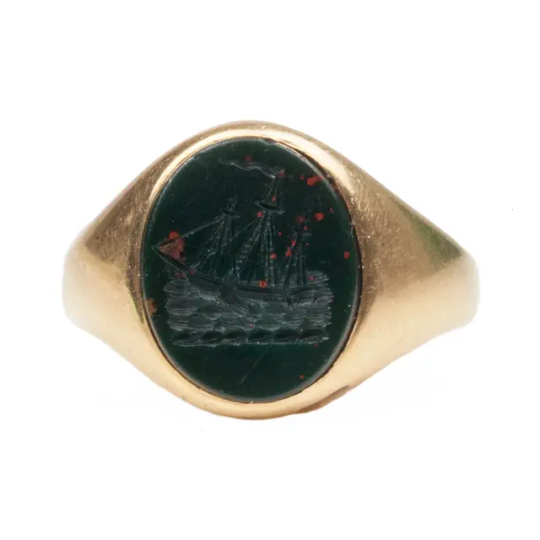
Bloodstone intaglio ring, set in gold with a hand-carved intaglio depiction of a three-masted ship sailing in the waves. Circa 1870.
138 notes
·
View notes
Text
Ancient Roman Dionysus Intaglio Ring


Ancient Roman, c. 3rd Century AD
An incredible ancient Roman intaglio ring dating from the 3rd Century AD. The carnelian panel has been carved to depict Dionysus, grasping a Thyrsus and drinking cup, and remains set in its original high-carat ring mount. Dionysus (known to the Romans as Bacchus) was the principle deity of one of the mystery cults, and made his way into Roman culture - along with many others - through Greek mythology. He was believed to have been born from the union of Zeus and Persephone, and to have himself represented a chthonic or underworld aspect of Zeus.
The cult believed in rebirth, as exemplified through the seasonal growth of nature, but also of revelation through ecstasy (aided by wine, music and ecstatic dance). His followers were freed from self-conscious fear and care, and could subvert the oppressive restraints of the powerful - possessed and empowered by the god himself.
(Source: www.butterlaneantiques.com)
#ancient rome#ancient jewelry#ancient ring#Dionysus Intaglio Ring#antique jewelry#3rd century ad#intaglio ring#dionysus#butter lane antiques
18 notes
·
View notes
Text



ROMAN GARNET INTAGLIO IN GOLD RING
Ca. 1-200 AD
#ROMAN GARNET INTAGLIO IN GOLD RING#Ca. 1-200 AD#gold#gold jewelry#roman jewelry#ancient jewelry#ancient artifacts#archeology#archeolgst#history#history news#ancient history#ancient culture#ancient civilizations#ancient rome#roman history#roman empire#roman art
739 notes
·
View notes
Text

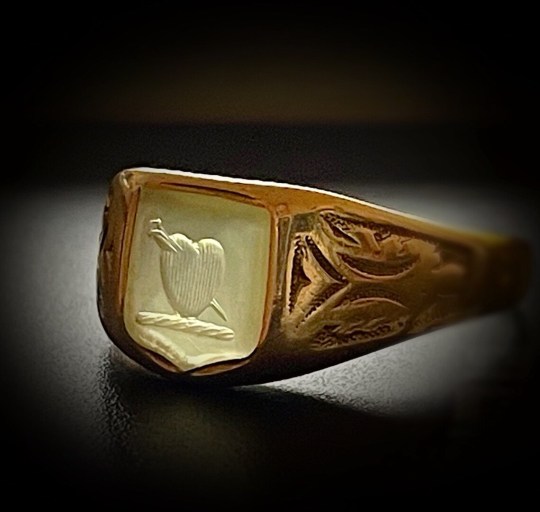
Victorian 14k Gold Chalcedony Intaglio Ring
198 notes
·
View notes
Text

#men’s jewelry#jewelry#vintage jewelry#Roman#vintagestyle#style#intaglio#signet ring#gold jewellery#gemstone
48 notes
·
View notes
Text
just watched a video about all the 2nd and 3rd century CE intaglio and women’s hair pins that archaeologists found in the drain of an ancient roman bathhouse and now i’m crying about humans being humans since forever losing jewelry or hair accessories in weird places 😭 i love us
9 notes
·
View notes
Text
English bloodstone griffin ring
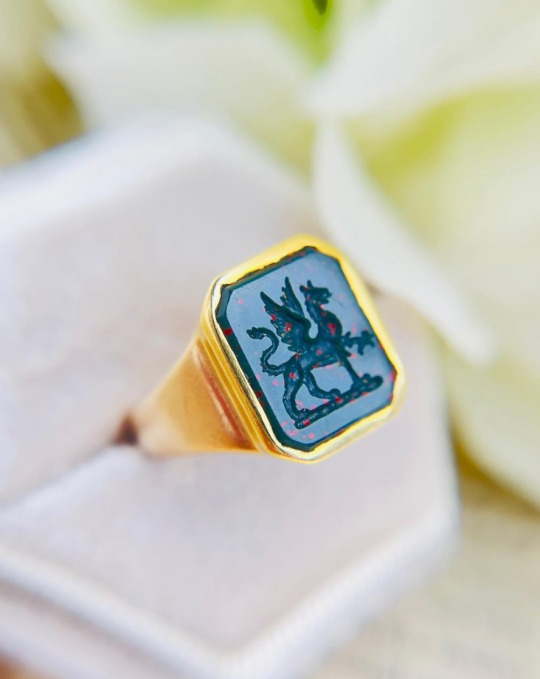
Bloodstone ring with carved griffin. English piece.
#intaglio#gold jewelry#gold ring#jewelry#vintagegold#vintage#vintage style#vintagejewelry#vintagering#goldring#gold#jewellery#ring
10 notes
·
View notes
Text


A gold Romano-British ring set with an amethyst intaglio of a winged figure riding a lion.
This ring is part of a hoard of late-Roman gold jewellery and silver tableware found near Thetford, Norfolk, in 1979.

#antique jewelry#antique ring#roman jewelry#romano-british#antique#intaglio#amethyst#engraved jewelry
12 notes
·
View notes
Text
I’ve been down a rabbit hole wondering about medieval jewelry (and if I can reproduce it despite having no metalworking skills, to which the answer is mostly no) lately & I figured I would share the fruits of my museum collection searches for other medievalists/hobbyists/reenactors/nerds.
Jewelry of the 13th Century Anglo/Francosphere

TL;DR
Metals: 🟨 gold(tone)
Stones: mostly 🔵 cabochon, rarely 💠 simple cut, some carved 🗿 intaglio or cameo
Stone Colors: warm blues, emerald green, purples, burgundies, reds
Materials: enamel, 💎 gemstones (garnet, Ceylon sapphire, ruby/spinel, emerald) or glass paste imitations, ⚪ semi-precious stones (pearl, lapis, jasper, carnelian, coral, turquoise, porphyry)
Settings: bezel (oval and rectangular); ⚜️ intricate metalwork; more visible and textured metal than modern jewelry; more mixtures of stones and colors than modern tastes
Motifs: ◯ round, ✤ quatrefoil, ✙ cross, ✸ star (even numbers of points), ♣ trefoil, ❦ floral, 🐉 animals, 𝕬 inscription
Formats: brooches, ornamented clothing, rings, pendants, circlets, cuffs (rare)
A detailed look:
Some forms of jewelry that were very popular in the Roman Empire and are again today were just not the thing in the middle European Middle Ages. (Earrings, for example, seem to have barely existed. This is partially at least because ears were covered--by coifs and caps, hair, and (for women) braids or the chin strap and fillet/wimple/gorget.) In fact, a lot of the places we would put jewelry against our skin today were covered.
This left some other options:
Jewelry on Clothing
Medallions
Okay, these aren’t jewelry, strictly speaking, but they’re metalwork ornaments associated with a person.
Enamel Mitre Medallions


OA 3437 and OA 3438
Before 1291, Ile de France
Louvre, Paris
photos (c) Musée du Louvre / Stéphane Maréchalle 2015
Cloisonné and plique enamel over gold and copper, with decorative motifs of trefoils, quatrefoil, and stars in a palette of dark blue and green with accents that may once have been ruby red.
Appliqué Medallion
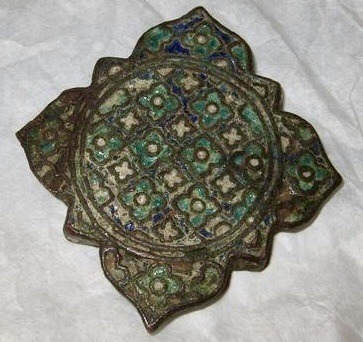
# MRR 256
13th c., Limoge
Louvre, Paris
photo (c) Musée du Louvre 2014
Gilded copper (though most gold is worn off) with quatrefoil champlevé enamel in emerald green, lapis blue, and white or off-white.
Brooches
Perhaps the most prevalent medieval jewelry item in the Anglo & French regions. These were worn at the shoulder for men and breast for women, often anchoring a cloak, or to close the collar. As the ornate fermail and double-ring brooch suggest, these ran the gamut from practical to incredibly decorative and ornate.
Garnet & Silver Gilt Animal Ring Brooch; Green and Blue Glass and Gilt Ring Brooch


Left, # 2003,0703.1
13th century; found in Suffolk, England
British Museum, London
photo (c) The Trustees of the British Museum
Right, # M.28-1929
13th c., England
V&A, London
photo © Victoria and Albert Museum, London
Cabochon garnets or carbuncles in the gilded silver brooch (L), perhaps once paired with smaller stones in the eyes of metalwork animals that bite the pin bracket. The right brooch, also silver gilt, sports two glass paste emerald and sapphire "gems" in cabochon. It was probably a lover's token; it reads (in Lombardic-lettered French) IOSV ICI ATI VCI or "jo su[i] ici a t[o]i v[o]ici" which I might translate as "I am here with/belonging to you, look!"
Ruby & Sapphire Ring Brooch; Sapphire, Garnet, and Pearl Fermail
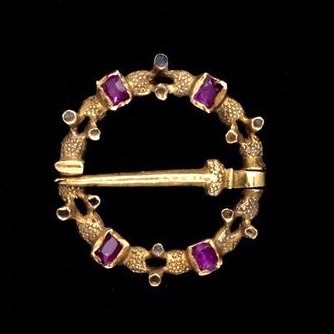
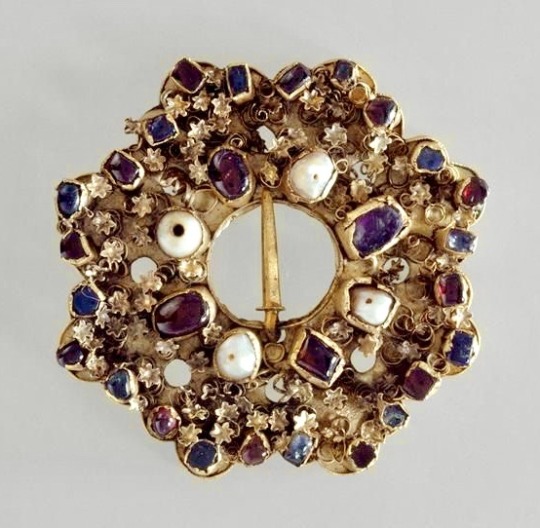
Left, # 6808-1860
1275-1300, England
V&A, London
photo © Victoria and Albert Museum, London
Right, # OA6287
1250-1300, France
Louvre, Paris
photo (c) Musée du Louvre
Blogs often claim that stones were only polished en cabochon until the 16th century, and that medieval jewelers couldn't cut gemstones. But this 13th-century gold ring brooch (left) pairs table-cut purple rubies with collet-set cabochon sapphires, and may evidence early medieval gem-cutting or reuse of Roman cut stones. The silver gilt fermail, right, includes pearl beads, garnets and sapphires both cut and cabbed, and one glass paste cabochon. Both are intricately textured, with punchwork (L) and floral metalwork, probably cast and then attached (R).
Double Ring Brooch with Sapphire and Glass "Emeralds"
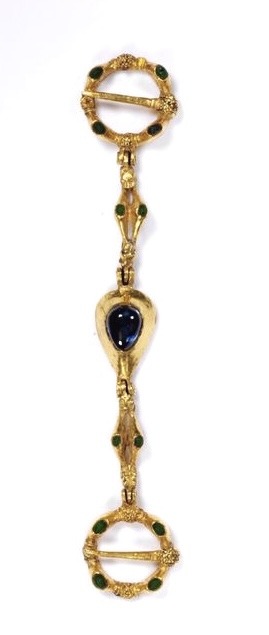
# M.26-1993
13th c., England
V&A, London
photo © Victoria and Albert Museum, London
This gold double brooch is so small they think it was for a woman or child. Central sapphire cab is flanked by glass paste "emeralds" in bezel settings and metalwork featuring two animal heads.
Jewelry on the Body
Rings
Many are probably familiar with the signet ring, used for pressing into sealing wax, which could be intaglio-carved gemstone or metals. There were also a number of decorative and/or talismanic gemstone rings.


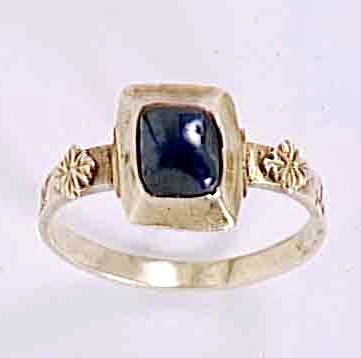
LtR:
#M.7-1929 | #M.180-1975 | #OA 11265
1250-1300, England | 1250-1300, Engl/France | 13th c., Engl/France
V&A, London | V&A, London | Louvre, France
photos L&C © Victoria and Albert Museum, London | R (c) Musée du Louvre
Sapphire in gold is the name of the game when it comes to rings in the thirteenth century; even the purple stones on the left are purple sapphires. (Sapphires were said to aid chastity, purity, and the effectiveness of prayer.) For larger stones, the bezel often has claws added (L); the central ring is an example of a full claw setting that modern viewers might find surprisingly tall. Naturalistic flourishes are added (C & R); these might be pre-cast then attached to the base (R).
Pendants
We equate pendants with necklaces, but their medieval applications also included wear as badges, from headpieces, and on horse decorations.


Left, bloodstone jasper cameo in silver setting
# MRR 218
1100-1300, France?
Louvre, Paris
photo (c) Musée du Louvre / Jean Blot 1984
Right, champlevé enamel, gilt copper, and paste "emerald" (harness) pendant
# 1976.169
13th c., France
Cleveland Museum of Art, Cleveland
photo CC0 Open Access
Statue Jewelry
From here, we get into the really ridiculous stuff; the previous categories could be relatively everyday (as much as ornamentation reserved exclusively for the wealthy can be an everyday thing) but the following examples are astonishing displays not necessarily for wear.
"La Couronne" de Vierge et l'Enfant d'ivoire de la Sainte-Chapelle

# OA 57 B
1250-1300, France
Louvre, Paris
photo (c) Musée de Louvre
This was not even a crown for a person, but rather for a painted ivory statue of the Virgin Mary, holding her infant son. (Though circlets, even set with stones, were sometimes worn as part of women's head dress.) It's incredibly ornate gold, set with pearls, garnets and rubies, sapphires, and turquoise (?) en cabochon.
Anneau de Saint-Denis




# MS 85 BIS
1200-1215, France
Louvre, Paris
photos (c) Musée du Louvre / Daniel Arnaudet 1990
This astonishing piece, which is ring-sized but now displayed as a cuff on an ivory hand, is made of gold and displays every possible gemstone appearance characteristic of the period. The front piece has a central sapphire and is surrounded by quartz with red backing (mimicking ruby/garnet), amethysts, pearls, and sapphires, some set on yellow backing (mimicking turquoise?). Most are en cabochon on this face, but two are faceted and two intaglio. Were this not enough, the three other 'faces' of the ring are set with gems as well, two cameos (probably sapphire and garnet?) and one amethyst intaglio set in ornate gold filigree.
#medieval#jewelry making#lapidary#history of fashion#historical jewelry#1200s#reenactment#England#France#enamel jewelry#ring brooch#fermail#intaglio#cameo#gemstones#infodumping#now time to go to the bead store#material history#you would think this is for my research or academically relevant but it's not I just couldn't stop looking at shiny things help#photos not mine#photos for educational purposes and not for commercial reproduction#louvre#v&a museum#british museum#cleveland museum of art
33 notes
·
View notes
Photo

Plain gold ring with an intaglio of bloodstone, on it a merchant vessel in a storm, c. 1870
This gentleman's ring was most likely worn by a merchant captain who used it to seal his documents.
104 notes
·
View notes
Text
Art Deco Bloodstone "Griffin & Sword" Intaglio Signet Ring
Superb antique signet ring set with a 3D geometrical cut bloodstone head with intaglio carved heraldic crest depicting a griffin holding a sword. The bloodstone presents a deep green colour - almost black - with flecks of red throughout, and ideal contrast to the high-carat yellow gold mount. Intricate floral and foliate engraving adorns the gallery, and it dates from the 1920s. Handmade throughout with SS maker's mark inside the band. Crafted in 15 karat gold.
The crest belongs to Clan Bannatyne of Scotland, worn by all of the name and ancestry and often seen alongside their Latin motto: "Nec Cito Nec Tarde" (neither fast nor slow). In heraldry-speak it would be described as: "A demi-griffin, in his dexter paw a sword erect, Proper"

(source: butterlaneantiques.com)
#signetring#bloodstonejewelry#bloodstone#griffin and sword#antiquejewelry#antiques#art deco jewelry#art deco fashion#dark jewelry#old gold#intaglio ring#intaglio
7 notes
·
View notes
Text
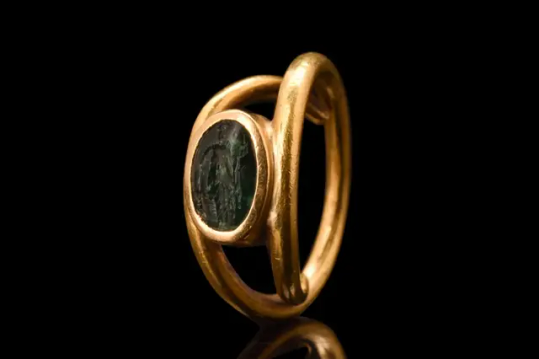



ROMAN EMERALD INTAGLIO WITH FORTUNA IN GOLD RING
Ca. 200-300 AD
An oval-shaped emerald intaglio that is engraved with a depiction of a standing figure of the goddess Fortuna set in a Victorian period gold ring formed of a round-section rod that is elegantly shaped, giving it a striking appearance. Fortuna, who is one of the most revered goddesses in Roman mythology was the goddess of fortune and luck, and she was believed to bring success and prosperity to those who worshipped her. She was often depicted as a standing figure, holding a cornucopia in one hand and a rudder in the other. The cornucopia symbolized abundance, while the rudder symbolized her control over destiny. The goddess was worshipped by people from all walks of life, including emperors, soldiers, and merchants, who sought her blessings for their endeavors.
#ROMAN EMERALD INTAGLIO WITH FORTUNA IN GOLD RING#Ca. 200-300 AD#gold#gold jewelry#roman jewelry#ancient jewelry#ancient artifacts#archeology#archeolgst#history#history news#ancient history#ancient culture#ancient civilizations#ancient rome#roman history#roman empire#roman art
556 notes
·
View notes
Text
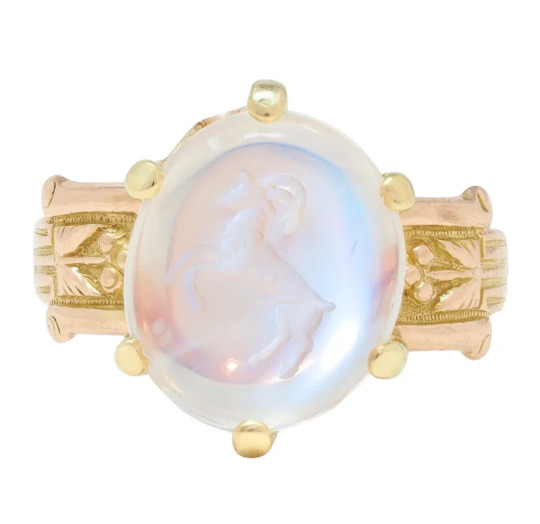

Victorian 14k Gold Moonstone Ram Intaglio Ring
314 notes
·
View notes
Photo

Vintage beetle cab ring 🖤 Reverse intaglio cab from before 1950 featuring a beetle ~ set in sterling silver ~ size 8 #vintagecab #vintagecabochons #intaglio #reverseintaglio #beetle #beetlejuice #beetlejuicebeetlejuicebeetlejuice #entomology #rings #metalsmith #jewelersofinstagram #statementring #pink https://www.instagram.com/p/CqdVU0fOdEl/?igshid=NGJjMDIxMWI=
#vintagecab#vintagecabochons#intaglio#reverseintaglio#beetle#beetlejuice#beetlejuicebeetlejuicebeetlejuice#entomology#rings#metalsmith#jewelersofinstagram#statementring#pink
7 notes
·
View notes
Text
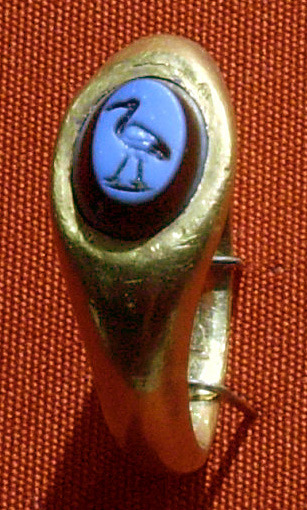
Ring with a nicolo intaglio of an ibis - Met Museum Collection
Inventory Number: 44.2.4
Roman Period, A.D. 2nd century
Location Information: Location Unlisted
Description:
A nicolo is an onyx agate cut to leave a thin layer of faint whitish blue over a thicker layer of black.
1 note
·
View note
Text

Amethyst intaglio in chased yellow gold.
2 notes
·
View notes